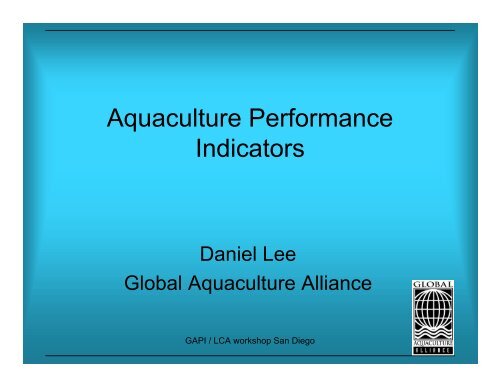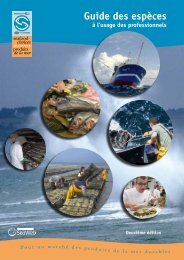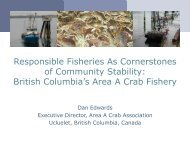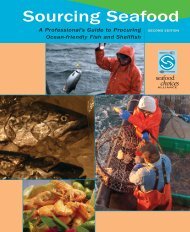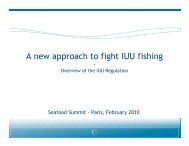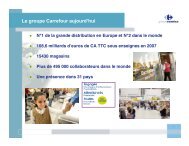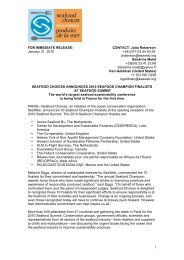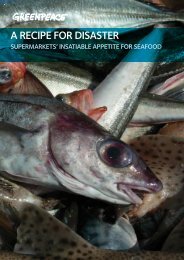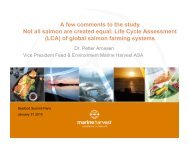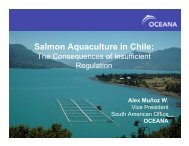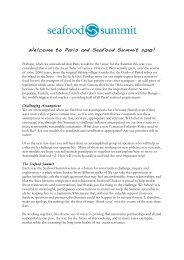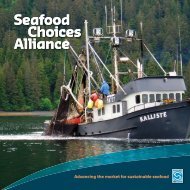Daniel Lee - Seafood Choices Alliance
Daniel Lee - Seafood Choices Alliance
Daniel Lee - Seafood Choices Alliance
You also want an ePaper? Increase the reach of your titles
YUMPU automatically turns print PDFs into web optimized ePapers that Google loves.
Aquaculture Performance<br />
Indicators<br />
<strong>Daniel</strong> <strong>Lee</strong><br />
Global Aquaculture <strong>Alliance</strong><br />
GAPI / LCA workshop San Diego
Outline<br />
1. Status of the BAP program<br />
2. Projections<br />
3. Quantitative indicators in BAP<br />
4. BAP and GAPI<br />
5. Measuring impact on wild fisheries<br />
GAPI / LCA workshop San Diego
Status of the BAP program<br />
– Standards for<br />
• Shrimp (farms, hatcheries)<br />
• Channel catfish<br />
• Tilapia<br />
• Processing plants<br />
– Next<br />
• Pangasius<br />
• Feedmills<br />
• Salmon<br />
GAPI / LCA workshop San Diego
BAP: Farm Participation<br />
(Worldwide)<br />
60<br />
50<br />
40<br />
119,711 mt<br />
(finished product,<br />
shrimp) 2008<br />
37<br />
51<br />
No. Farms<br />
30<br />
20<br />
18<br />
10<br />
5<br />
7<br />
9<br />
0<br />
2003 2004 2005 2006 2007 2008<br />
GAPI / LCA workshop San Diego
BAP: Processing Plants Participation<br />
(Worldwide)<br />
80<br />
70<br />
60<br />
378,607 mt<br />
(finished product,<br />
shrimp) 2008<br />
63<br />
73<br />
No. Plants<br />
50<br />
40<br />
30<br />
20<br />
10<br />
0<br />
45<br />
3<br />
5<br />
2004 2005 GAPI / LCA workshop 2006San Diego 2007 2008
Latest Supply Data<br />
• BAP shrimp from plants 378,607 MT (2008)<br />
• BAP Tilapia from plants 40,408 MT (2008)<br />
• BAP Farm shrimp 119,711 MT (2008)<br />
• BAP Farm Tilapia 6,000 MT (January 2009)<br />
• BAP Farm Catfish 16,000 MT (January 2009)<br />
GAPI / LCA workshop San Diego
Projected Availability of Certified Farmed <strong>Seafood</strong><br />
% of US market<br />
60<br />
50<br />
40<br />
30<br />
20<br />
10<br />
0<br />
shrimp<br />
tilapia, catfish<br />
salmon<br />
molluscs<br />
trout<br />
2006<br />
2007<br />
2008<br />
2009<br />
2010<br />
2011<br />
2012<br />
2013<br />
2014<br />
2015<br />
2016<br />
GAPI / LCA workshop San Diego
BAP: existing<br />
performance metrics<br />
• Some key performance requirements are<br />
not suitable for comparative purposes, e.g:<br />
– Mangrove displacement = 0<br />
– Use of banned antibiotics = 0<br />
– Salinization of land, water = 0<br />
– Use of wild post-larvae = 0<br />
GAPI / LCA workshop San Diego
BAP: existing<br />
performance metrics<br />
• Farm level<br />
– Effluent concentration limits (pH, TSS, P, N, BOD, DO)<br />
– Water use and load indices<br />
• eg water use (m 3 /kg fish)<br />
• eg soluble phosphorus (kg/ton of fish)<br />
– Feeding rate limits<br />
• for cage farms in lakes<br />
– FCR<br />
– Fish in: Fish out Ratio (= FFER)<br />
– Fish welfare<br />
• Biomass maximum<br />
• Max periods for fasting, crowding, time out of water<br />
GAPI / LCA workshop San Diego
BAP: Existing eco-system level<br />
performance metrics<br />
• Feeding rate limits for lakes, reservoirs<br />
– for combined input from all farms, depending on water<br />
surface area and hydraulic retention time<br />
GAPI / LCA workshop San Diego
GAPI vs FLAPI<br />
• FLAPI<br />
= farm-level aquaculture performance index<br />
• Potential for conveying messages<br />
– to individual farmers: BAP, FLAPI<br />
– to consumers: BAP<br />
– to national and international policymakers:<br />
GAPI<br />
GAPI / LCA workshop San Diego
Potential compatibility between<br />
BAP and FLAPI approaches<br />
– BAP could require each farm to calculate an<br />
overall performance index (=FLAPI)<br />
– Then set minimum FLAPI<br />
– Progressively raise minimum FLAPI over time<br />
GAPI / LCA workshop San Diego
Fish in: Fish out ratios for major, fed aquaculture species<br />
(data from Tacon and Metian, 2008)<br />
Ratio<br />
8<br />
7<br />
6<br />
5<br />
4<br />
3<br />
2<br />
1<br />
0<br />
salmon<br />
trout<br />
eel<br />
marine fish<br />
shrimp<br />
f/w crustaceans<br />
tilapia<br />
catfish<br />
milkfish<br />
fed carp<br />
total<br />
1995<br />
1997<br />
1999<br />
2001<br />
2003<br />
2005<br />
2007<br />
2009<br />
2011<br />
2013<br />
2015<br />
2017<br />
2019<br />
GAPI / LCA workshop San Diego
Wild fish used in feed for the fish and shell<br />
fish most commonly farmed in 1997*<br />
Production with<br />
compound diets<br />
(kilotonnes)<br />
fishmeal fish oil wild fish<br />
Species/group<br />
(%) (%) FCR used<br />
marine finfish 377 50 15 2.2 1944 5.16<br />
eel 117 50 10 2 546 4.69<br />
shrimp 725 30 2 2 2040 2.81<br />
salmon 737 45 25 1.5 2332 3.16<br />
trout 473 35 20 1.5 1164 2.46<br />
tilapia 331 15 1 2 466 1.41<br />
milkfish 78 10 3 2 74 0.94<br />
catfish 351 10 3 1.8 296 0.84<br />
fed carps 2445 8 1 2 1834 0.75<br />
GAPI / LCA workshop San Diego<br />
fish in: fish<br />
out ratio<br />
Overall 5634 10696 1.90<br />
* Naylor et al. 2000, excluding filter feeding carps<br />
and molluscs
Wild fish used in feed for fish<br />
and shell fish in 2007 *<br />
Species/group<br />
Production with<br />
compound diets<br />
(kilotonnes)<br />
fishmeal<br />
(%)<br />
fish oil<br />
(%) FCR<br />
wild fish<br />
used (m.)<br />
wild fish<br />
used (o.)<br />
fish in:<br />
fish out<br />
ratio (m.)<br />
fish in:<br />
fish out<br />
ratio (o.)<br />
shrimp 3544 18% 2% 1.58 4484 2240 1.27 0.63<br />
marine fish 1690 30% 7% 1.37 3080 3240 1.82 1.92<br />
salmon 1538 24% 16% 1.25 2053 6160 1.33 4.01<br />
trout 683 24% 12% 1.25 911 2040 1.33 2.99<br />
chinese carps 10736 5% 0% 0.80 1906 0 0.18 0.00<br />
catfish 2080 8% 2% 1.08 800 760 0.38 0.37<br />
eel 279 50% 5% 1.43 884 400 3.17 1.43<br />
misc f/w carnivores 855 40% 5% 0.34 516 300 0.60 0.35<br />
f/w crustaceans 1119 14% 2% 0.99 689 340 0.62 0.30<br />
tilapia 2575 5% 0% 1.39 800 0 0.31 0.00<br />
milkfish 608 3% 1% 0.82 67 100 0.11 0.16<br />
Overall 25707 16189 15580 0.63 0.61<br />
* Tacon and Metian (2008)<br />
GAPI / LCA workshop San Diego
Efficient use of wild fish inputs<br />
Fish in: fish out ratios for 2007*<br />
salmon: 4.0<br />
shrimp: 1.26<br />
Thus a simple sum:<br />
4.00 kg of wild fish needed for 1kg salmon<br />
1.26 kg of wild fish needed for 1kg shrimp<br />
5.26 kg of wild fish needed for 1kg salmon and 1kg shrimp<br />
No!<br />
• Fish in: fish out ratios can be very misleading<br />
* (Tacon and Metian 2008)<br />
GAPI / LCA workshop San Diego
Typical fishmeal and fish oil content of aquaculture diets<br />
(based on Tacon & Metian (2008))<br />
18%<br />
16%<br />
14%<br />
12%<br />
salmon<br />
trout<br />
fish oil<br />
10%<br />
8%<br />
6%<br />
4%<br />
2%<br />
0%<br />
milkfish<br />
tilapia<br />
catfish<br />
shrimp<br />
f/w crustaceans<br />
(forage fish)<br />
0% 10% 20% 30% 40% 50% 60%<br />
fishmeal<br />
marine fish<br />
GAPI / LCA workshop San Diego<br />
misc. f/w<br />
carnivores<br />
eel
Actual yield from 5.26 kg of wild fish:<br />
• Optimised ratio of salmon and shrimp, using<br />
all the oil and meal in 5.26kg of wild fish<br />
yields:<br />
0.8 kg salmon, plus<br />
3.3 kg shrimp<br />
4.2 kg salmon and shrimp<br />
• Traditional fish in: fish out calculation<br />
underestimates the overall efficiency of<br />
aquaculture<br />
GAPI / LCA workshop San Diego
Conclusions<br />
• BAP for farm performance level<br />
• Possibly adopt GAPI method = FLAPI<br />
• FLAPI and GAPI for different audiences<br />
• Quantitative indicators must be well<br />
designed<br />
• Danger of ‘hitting the target but missing<br />
the point’<br />
GAPI / LCA workshop San Diego


